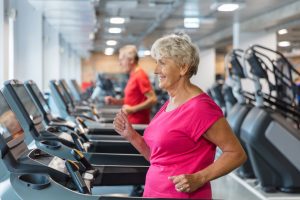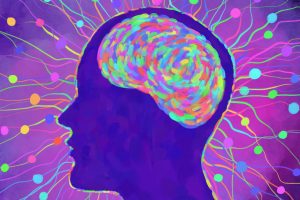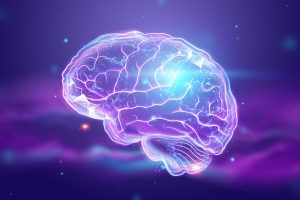
How Aerobics Can Revolutionize Neurological Rehab
Treatment GuidelinesAerobic exercise offers the potential to not just mend but revitalize. It’s time to elevate this unsung hero of recovery so that it becomes a cornerstone, rather than an afterthought, in neurological rehab.
Neurological rehabilitation spans a complex landscape of interconnected health challenges. Among these, an astounding 75% of stroke survivors exhibit cardiac disease.1 Cardiac disease is not merely a concurrent condition. It is a significant contributor to disability and the leading cause of death for post-stroke patients.1,2
Despite this alarming connection, aerobic exercise is widely underutilized in neurological rehabilitation. After initial treatment, patients with neurological conditions usually begin a personalized rehab program. In general, the prescribed exercises focus on balance, strength, and motor skills. Aerobic exercise is a critical component of comprehensive recovery, but it is frequently undervalued and omitted.
Aerobic exercise offers the potential to not just mend but revitalize. It’s time to elevate this unsung hero of recovery so that it becomes a cornerstone, rather than an afterthought, in neurological rehab.
Why Aerobic Exercise Is Underutilized in Neurological Rehabilitation
Increasing aerobic exercise is the foundation for many other rehabilitation programs. This includes cardiac rehab and pulmonary rehab, as well as general health and wellness guidelines. So why should neurological rehab be any different? Reduced cardiac health only compounds the obstacles that survivors face following a neurological injury.
Perhaps one reason cardio is underutilized is that therapists tend to prioritize immediate functional needs. As we know, neurological injury can be accompanied by many different physical and cognitive deficits. This includes hemiparesis, hemiplegia, spasticity, muscle tone, and poor coordination. With these pressing concerns, therapists may find their attention and time fully consumed. Therefore, most exercise programs prioritize range of motion, strength, balance, motor skills, etc. However, while heel raises and bridges are undoubtedly beneficial, neglecting aerobic exercise leaves out a crucial aspect of rehabilitation.
There are additional reasons for the underutilization of aerobics for neurological rehab. For example, limited information or guidance on aerobic exercise prescription likely plays a large role.3 Combined with time constraints and pressure to maximize billing, this can discourage rehab professionals and lead to underutilization of aerobic exercise. Furthermore, many individuals affected by neurological injury have decreased exercise tolerance.3 This can limit participation in cardio activities.
Individuals affected by a traumatic brain injury (TBI) have been found to have an aerobic capacity that is 25-30% reduced when compared to healthy sedentary individuals.4 This can lead to reduced endurance for daily activities and a greater risk of additional neurological injuries. For someone recovering from a TBI, this further increases the likelihood of developing additional complications, including reductions in lung function, pituitary function, and hormone production.4
How Aerobics Improves Neurological Rehabilitation Outcomes
The list of health benefits of aerobics for neurological injury is extensive. By implementing healthy lifestyle changes, such as increasing physical activity, the risk of cardiovascular mortality in stroke survivors can reduce by as much as 92%.5 Additionally, aerobic exercise may facilitate improvement in cognitive function and information processing.6
The advantages of aerobics for neurological conditions aren’t just seen in late-stage rehab. On the contrary, aerobics can be a useful tool in the acute phase of recovery. Aerobic exercise has been shown to reduce stroke-induced brain lesions within the first 28 days after stroke.6 Furthermore, researchers have explored the impact of aerobic activity on neuroplasticity. In animal studies, aerobic exercise was found to consistently regulate neurotrophic factor synthesis.6 This can allow survivors to capitalize on neuroplasticity in the early stages when it is most active.
After a neurological injury like a stroke or TBI, the resulting damage to brain tissue can impact automatic processes. For example, stroke survivors who are deconditioned often experience metabolic disturbances as a result. These changes in metabolic activity increase the risk of both heart attack and recurrent stroke.2 In truth, cardiovascular comorbidities constitute the leading cause of death in the post stroke-population.2
Clinical Evidence on Aerobics for Stroke Patients
The rate of impaired glucose metabolism is as high as 80% in post-stroke populations.2 However, evidence suggests that regular aerobic exercise can positively impact insulin resistance and glucose tolerance.2 This, combined with improved cardiac health, can significantly improve a survivor’s health and well-being.
The pros of aerobics for neurological rehab just stop at the chemical level. Treadmill aerobic training was found to be more effective than conventional rehab at improving ambulatory function for those affected by chronic stroke.7 Furthermore, there is evidence for improved upper limb function and general muscle fiber changes due to aerobic training.8,9
Stroke survivors commonly have low tolerance for aerobic exercise. Research shows that exercise with BTE’s eccentric-only resistance system, Eccentron, is safe and effective for post-stroke patients. Because this system uses eccentric resistance, rather than concentric, it facilitates efficient aerobic exercise while requiring less energy consumption.10 Post-stroke, post-operative, and deconditioned patients can gradually build strength and aerobic endurance by performing eccentric-only resistance training. Increasing aerobic activity and lower extremity strength are key to improve overall health for stroke survivors.
Aerobics Slows Progression of Parkinson’s Diseae
Parkinson’s disease is progressive, and affected individuals experience a gradual decline in function. However, new evidence suggests aerobic exercise can help slow the progression of Parkinson’s disease.11 A recent clinical review found high-intensity aerobic exercise to have the greatest disease-modifying potential. In this review, individuals who participated in regular exercise experienced a slower decline in gait and the activities of daily living.11
Furthermore, aerobic exercise was shown in other studies to improve gait, balance, and overall quality of life.12 By making cardiovascular exercise a priority, individuals can take charge of their rehabilitation after a Parkinson’s diagnosis. While this condition is progressive, improving functional mobility can boost autonomy, independence, and even mental health.
Aerobics and Mood Disorders
The benefits of aerobics for neurological conditions extend beyond just physical improvements. There is substantial evidence to support the use of aerobic exercise as an intervention for mood and behavioral disorders.
Depending on the injury, survivors often experience changes in mood, behavior, and emotions. This can include conditions such as anxiety and depression, which are compounded by the loss of independence many individuals experience.
While medication is beneficial for many to reduce the severity of mood and behavioral changes, this is not the only available treatment. By enhancing neuroplasticity and preventing atrophy of the hippocampus, aerobic activity can improve symptoms of depression.13 Additionally, this is an effective intervention for chronic pain conditions after neurological injury.13
In one study of aerobics for individuals with TBI, both acute and long-term improvements in mood were recorded.14 While improvements were noted as early as 4 weeks, the greatest impact on overall mood was at the 12-week mark.14
Barriers to Aerobics for Neurological Patients
Understanding the importance of aerobics for neurological injury is vitally important. However, putting this knowledge into practice comes with its own challenges. Even when survivors are aware of the need for aerobic exercise, the barriers can seem overwhelming. These barriers can include limited social support, poor motivation, reduced physical function, and emotional condition.5
Among individuals with a traumatic brain injury, knowing how and where to exercise is a major concern.15 When combined with motor impairments like weakness, paralysis, or ataxia, this can feel impossible. Therefore, providers need to work closely with patients to provide guidance for continued exercise after discharge from therapy. By enabling survivors of neurological injury to be active in their rehabilitation, we can maximize therapeutic outcomes.
Research suggests that 20-40 minutes of light aerobic exercise performed 3-5 days per week is optimal.4 However, every program should be tailored to meet the individual needs of the survivor. Finding ways that your patient can be successful at aerobic activity is vital for encouraging independence and self-efficacy. This can include walking, arm or leg cycling, swimming, or an aerobic circuit workout. Additionally, community exercise programs can be a great place to start. Exercise can always be adapted to meet an individual’s needs.
Easy Aerobics for Neurological Patients
Patients struggling with low exercise tolerance or deconditioning can still benefit from light aerobic exercise. Combined with the minimal energy requirements of eccentric-only resistance, the Eccentron provides gentle and gradual exercise for patients with low tolerance. Learn more about facilitating gentle aerobics for deconditioned patients with the Eccentron here.
Emphasizing Well-rounded Rehab
Aerobic exercise is not a replacement for strength training for populations with neurological injury. However, it is a valuable adjunct to maximize recovery and decrease mortality. This is because of the impact aerobic exercise can have on so many aspects of health after neurological injury.
Improving cardiac function and endurance should be a consideration for all neurological rehabilitation programs. After injury and hospitalization, muscle atrophy and decreased endurance are limiting factors for a survivor’s daily function. However, intentional aerobic training can help overcome this reduction in function and increase independence.
Treating more than just strength-related impairments can better meet the needs of survivors of neurological injury. Addressing cardiac disease, mood disorders, endurance, and aerobic capacity are overlooked pieces of neurological rehabilitation. By making aerobic exercise a priority, survivors can take charge of their recovery and optimize functional outcomes.
Mariah Kellogg, PT, DPT is a Physical Therapist and health writer. Her career focuses on rehabilitation for neurological and orthopedic populations and she is passionate about patient advocacy. Mariah began her career in Alaska and uses writing as a tool to inspire patients to pursue their health goals as well as to engage with other clinicians about rehab topics.
References
- Stoller O, de Bruin ED, Knols RH. et al.Effects of cardiovascular exercise early after stroke: systematic review and meta-analysis. BMC Neurol 12, 45 (2012). https://doi.org/10.1186/1471-2377-12-45
- Ivey FM, Hafer-Macko CE, Macko RF. Exercise training for cardiometabolic adaptation after stroke. J Cardiopulm Rehabil Prev. 2008 Jan-Feb;28(1):2-11. doi: 10.1097/01.HCR.0000311501.57022.a8. PMID: 18277823.
- Billinger SA, Boyne P, Coughenour E, Dunning K, Mattlage A. Does aerobic exercise and the FITT principle fit into stroke recovery? Curr Neurol Neurosci Rep. 2015;15(2):519. doi: 10.1007/s11910-014-0519-8. PMID: 25475494; PMCID: PMC4560458.
- Mossberg KA, Amonette WE, Masel BE. Endurance training and cardiorespiratory conditioning after traumatic brain injury. J Head Trauma Rehabil. 2010 May-Jun;25(3):173-83. doi: 10.1097/HTR.0b013e3181dc98ff. PMID: 20473091; PMCID: PMC2885899.
- Bailey RR. Lifestyle Modification for Secondary Stroke Prevention. Am J Lifestyle Med. 2016 Feb 21;12(2):140-147. doi: 10.1177/1559827616633683. PMID: 30202386; PMCID: PMC6124986.
- Zhang D, Lu Y, Zhao X, Zhang Q, Li L. Aerobic exercise attenuates neurodegeneration and promotes functional recovery – Why it matters for neurorehabilitation & neural repair. Neurochem Int. 2020 Dec;141:104862. doi: 10.1016/j.neuint.2020.104862. Epub 2020 Oct 6. PMID: 33031857.
- Macko RF, Ivey FM, Forrester LW, Hanley D, Sorkin JD, Katzel LI, Silver KH, Goldberg AP. Treadmill exercise rehabilitation improves ambulatory function and cardiovascular fitness in patients with chronic stroke: a randomized, controlled trial. Stroke. 2005 Oct;36(10):2206-11. doi: 10.1161/01.STR.0000181076.91805.89. Epub 2005 Sep 8. PMID: 16151035.
- Kato A, Hayashi H. Aerobic Exercise for Upper Limb Function in a Patient With Severe Paralysis With Subacute Stroke: A Case Report. Cureus. 2023 May 25;15(5):e39502. doi: 10.7759/cureus.39502. PMID: 37378161; PMCID: PMC10291986.
- Potempa K, Braun LT, Tinknell T, Popovich J. Benefits of aerobic exercise after stroke. Sports Med. 1996 May;21(5):337-46. doi: 10.2165/00007256-199621050-00003. PMID: 8724202.
- Lim S, Lee W. Effect of two types of muscle contraction training on muscle thickness, strength, and delayed onset of muscle soreness in persons with chronic stroke. Physical Therapy Rehabilitation Science. Korean Academy of Physical Therapy Rehabilitation Science; 2018. Available from: https://www.jptrs.org/journal/view.html?doi=10.14474%2Fptrs.2018.7.4.154
- Schootemeijer S, Darweesh SKL, de Vries NM. Clinical Trial Highlights – Aerobic Exercise for Parkinson’s Disease. J Parkinsons Dis. 2022;12(8):2297-2306. doi: 10.3233/JPD-229006. PMID: 36336942; PMCID: PMC9837678.
- Shu HF, Yang T, Yu SX, Huang HD, Jiang LL, Gu JW, Kuang YQ. Aerobic exercise for Parkinson’s disease: a systematic review and meta-analysis of randomized controlled trials. PLoS One. 2014 Jul 1;9(7):e100503. doi: 10.1371/journal.pone.0100503. PMID: 24983753; PMCID: PMC4077570.
- Jia Y, Yao Y, Zhuo L, Chen X, Yan C, Ji Y, Tao J, Zhu Y. Aerobic Physical Exercise as a Non-medical Intervention for Brain Dysfunction: State of the Art and Beyond. Front Neurol. 2022 May 13;13:862078. doi: 10.3389/fneur.2022.862078. PMID: 35645958; PMCID: PMC9136296.
- Weinstein AA, Chin LMK, Collins J, Goel D, Keyser RE, Chan L. Effect of Aerobic Exercise Training on Mood in People With Traumatic Brain Injury: A Pilot Study. J Head Trauma Rehabil. 2017 May/Jun;32(3):E49-E56. doi: 10.1097/HTR.0000000000000253. PMID: 27603762; PMCID: PMC5339064.
- Pinto SM, Newman MA, Hirsch MA. Perceived Barriers to Exercise in Adults with Traumatic Brain Injury Vary by Age. J Funct Morphol Kinesiol. 2018 Sep 14;3(3):47. doi: 10.3390/jfmk3030047. PMID: 33466976; PMCID: PMC7739410.
- Petrofsky J, Donatelli R, McKivigan J, Laymon M. Can eccentric exercise of the lower limb be made more efficiently, a pilot study. Sunkrist Public Health and Research Journal. Vol1:1: 1-8 https://www.researchgate.net/publication/337062603_Can_eccentric_exercise_of_the_lower_limb_be_made_more_efficiently_a_pilot_stud





